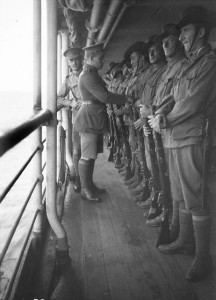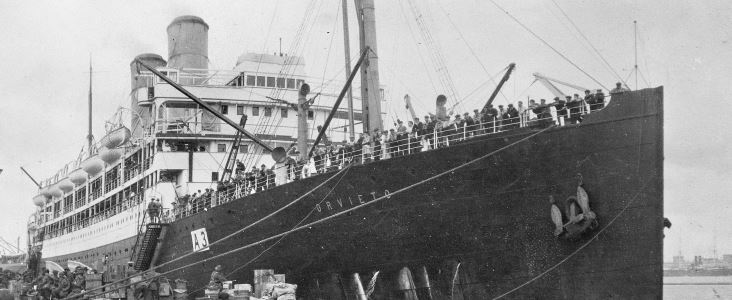HMAT Orvieto Embarkation
On 4 August 1914 Great Britain declared war on Germany. Just months later, on 1 November, Australia answered the call to war and deployed the first Australian/New Zealand convoy of 38 ships.
In the lead-up to this, enormous crowds gathered at Station Pier (then known as Railway Pier) in Port Melbourne to farewell the Victorian servicemen and women.
Sixteen ships left from Station Pier between 17 and 21 October 1914, headed to Albany, WA, before joining the convoy that would take them to Egypt.
The HMAT Orvieto was one of the largest ships to embark from Port Melbourne, carrying 1,457 men and women, representing Victoria’s significant contribution to World War I.
Their stories serve as an important part of our State’s history and ensure we never forget the sacrifice they made.
In 2014, the State Government will commemorate the centenary of the Orvieto and other World War I embarkations.
HMAT Orvieto Embarkation – 99th Anniversary at Princes Pier
Descendants of Victoria’s first Anzacs joined the State Government to mark the 99th anniversary of the HMAT Orvieto embarkation and acknowledged the upcoming Anzac Centenary. View the highlights here.
HMAT ORVIETO EMBARKATION
Historical footage of the HMAT Orvieto departing Port Melbourne in 1914, bound for the First World War.
message from the victorian anzac centenary committee
Ted Baillieu, Victorian Anzac Centenary Committee Chair, outlines the Victorian Government Anzac Centenary Program and acknowledges the 99th anniversary of the HMAT Orvieto embarkation.
Download Ted Baillieu Anzac Centenary Commemorations Video (20 Mb)
To SHARE YOUR STORY please enter your details here
Further history

A guard of the 5th Battalion on board A3 HMAT Orvieto, 1914. Reprinted courtesy of the Australian War Memorial.
On 21 October 1914 at about 2.30 in the afternoon, at Port Melbourne, the Governor-General of Australia, Sir Ronald Munro-Ferguson, his wife and party boarded His Majesty’s Australian Transport Ship No 3, Orvieto to farewell Australian troops departing for war. The Governor-General was there for the departure and bid farewell to Sir William Throsby Bridges, Commander of the First Australian Division.
A short while later, after the Governor-General and his party left the ship, the Orvieto began to depart. The band of the 5th Battalion played the National Anthem and crowds on the pier watched in delight as the soldiers on board stood to attention.
The Orvieto reached Albany on 26 October. On 28 October, 14 ships were seen on the horizon; the leading ship, a destroyer, escorting into King George Sound thirteen additional transport ships. These transports carried soldiers from New Zealand who would travel in convoy with the Australians.
On 1 November 1914, with all the details sorted out, the coaling and supplying finalised, some soldiers moved from overcrowded ships to less crowded ones, everything finally at the ready, thirty-six transports and three escorting cruisers sailed out of the Sound and into the waiting ocean.
The troopships that left Melbourne in the first Convoy included:
- A1 HMAT Hymettus
- A2 HMAT Geelong
- A3 HMAT Orvieto
- A4 HMAT Pera
- A5 HMAT Omrah
- A9 HMAT Shropshire
- A10 HMAT Karroo
- A15 HMAT Star of England
- A18 HMAT Wiltshire
- A20 HMAT Hororata
- A21 HMAT Marere
- A22 HMAT Rangatira
- A24 HMAT Benalla
- A25 HMAT Anglo Egyption
- A26 HMAT Armadale
- A27 HMAT Southern
- A28 HMAT Militiades
Visit the Australian War Memorial to search individual World War I embarkation rolls.
This list is based on a variety of sources and the best available information.






